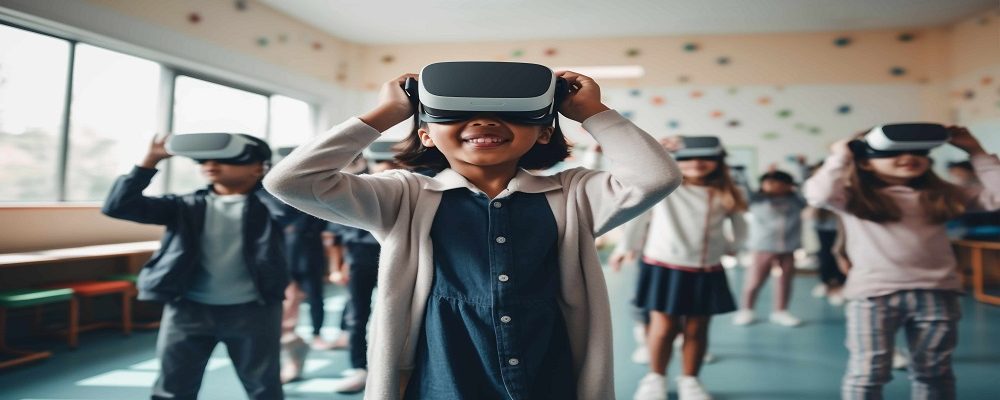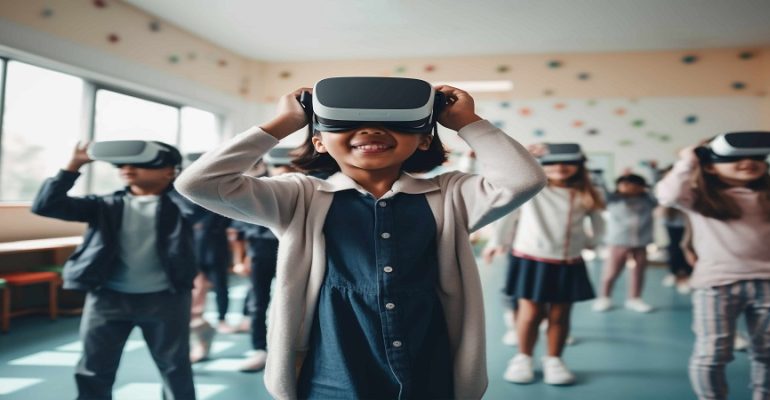
Extended reality in education

Extended reality in education
The advent of extended reality (XR) technology is reshaping the landscape of education, providing innovative tools that transform traditional learning environments into immersive, interactive experiences. Extended reality, which encompasses virtual reality (VR), augmented reality (AR), and mixed reality (MR), offers a new realm of possibilities for educators and students alike. From virtual field trips to historical reenactments, XR technology is making learning more engaging, accessible, and impactful.
Virtual Field Trips: Exploring Beyond Boundaries
One of the most exciting applications of XR in education is the ability to take students on virtual field trips. Imagine a history class where students can explore ancient Rome, walk through the streets, and interact with historical figures. With XR technology, this is not just a fantasy but a tangible reality. Virtual field trips eliminate geographical and financial barriers, allowing students to visit places they might never have the opportunity to see otherwise.
For instance, in a geography class, students can embark on a journey to the Amazon rainforest, observe the diverse ecosystem, and learn about the indigenous cultures that inhabit the region. These immersive experiences not only enhance understanding but also foster a sense of global awareness and empathy.
Immersive History Lessons: Reliving the Past
History is often perceived as a collection of dates and events to be memorized. However, XR technology can breathe life into historical narratives, making them more relatable and memorable. Extended reality can recreate significant historical events, allowing students to witness and participate in these moments. For example, students can experience the signing of the Declaration of Independence or stand on the battlefield of Gettysburg.
By placing students in the midst of history, XR encourages active learning and critical thinking. They can analyze the causes and consequences of events, understand the perspectives of different historical figures, and engage in discussions that deepen their comprehension and retention of historical knowledge.
Enhancing Geography Education: A New Perspective on the World
Geography education benefits immensely from the integration of XR technology. Traditional methods often rely on static maps and textbooks, which can limit students’ understanding of spatial relationships and geographic concepts. Extended reality offers a dynamic and interactive approach to learning geography.
Students can explore different terrains, climates, and ecosystems in a 3D environment. They can study the effects of natural disasters like earthquakes and tsunamis in real-time simulations, observing their impact on the environment and human settlements. This hands-on experience not only makes learning more engaging but also helps students grasp complex concepts more effectively.
Interactive Science Experiments: Bridging Theory and Practice
Science education can also be revolutionized with XR technology. Conducting experiments in a traditional classroom setting can be limited by resources, safety concerns, and time constraints. XR provides a solution by enabling students to perform virtual experiments in a safe and controlled environment.
For instance, in a chemistry class, students can mix chemicals and observe reactions without the risk of accidents. In biology, they can explore the human body in 3D, dissecting virtual specimens to learn about anatomy and physiology. These interactive experiences bridge the gap between theory and practice, allowing students to apply their knowledge and develop critical thinking skills.
Personalized Learning: Catering to Individual Needs
One of the significant advantages of XR technology in education is its ability to offer personalized learning experiences. Every student has a unique learning style and pace. XR can adapt to these individual needs, providing customized content and feedback.
For example, a student struggling with a particular concept in math can use XR applications that offer step-by-step guidance and interactive exercises tailored to their learning level. This personalized approach ensures that no student is left behind and that each learner can progress at their own pace.
Preparing Students for the Future
As XR technology continues to evolve, it is becoming increasingly important for students to be familiar with these tools. By integrating XR into the education system, we are not only enhancing current learning experiences but also preparing students for the future. Skills such as spatial awareness, problem-solving, and digital literacy are becoming essential in various fields, from engineering to healthcare.
Moreover, XR technology can foster creativity and innovation, encouraging students to think outside the box and develop solutions to real-world problems. As they engage with these immersive technologies, students are inspired to explore new possibilities and pursue careers in emerging industries.
Mandating XR Technology in Education
To fully harness the potential of XR in education, all schools and educational institutions should be mandated to incorporate XR technology into their teaching methodologies. This mandate would ensure a standardized approach to integrating cutting-edge technology across all levels of education, bridging the digital divide and ensuring equal access to advanced learning tools.
The benefits of mandating XR in education are manifold:
1. Equity in Education: By mandating the use of XR, every student, regardless of their socioeconomic background, would have access to the same advanced educational tools, promoting equity and inclusivity in education.
2. Enhanced Learning Outcomes: With XR, students can engage in more interactive and immersive learning experiences, leading to better understanding and retention of information. This can significantly improve learning outcomes across various subjects.
3.Teacher Training and Development: Mandating XR would necessitate comprehensive training programs for teachers, ensuring they are well-equipped to utilize these technologies effectively in the classroom. This would also contribute to ongoing professional development for educators.
4. Future-Ready Students: Integrating XR into the curriculum prepares students for future careers in a tech-driven world. It equips them with essential skills and knowledge, making them more competitive in the global job market.
5. Innovative Teaching Methods: XR can inspire educators to develop new, creative ways of teaching. This can make learning more dynamic and interesting, fostering a love for learning among students.
Conclusion
The incorporation of extended reality technology in education is a game-changer. It transforms the way students learn and interact with information, making education more immersive, engaging, and effective. From virtual field trips to interactive science experiments, XR offers endless possibilities for enriching the educational experience. As we embrace this technology and mandate its use across all educational institutions, we are not only enhancing learning outcomes but also equipping students with the skills and knowledge they need to thrive in a rapidly changing world. The future of education is here, and it is extended reality.